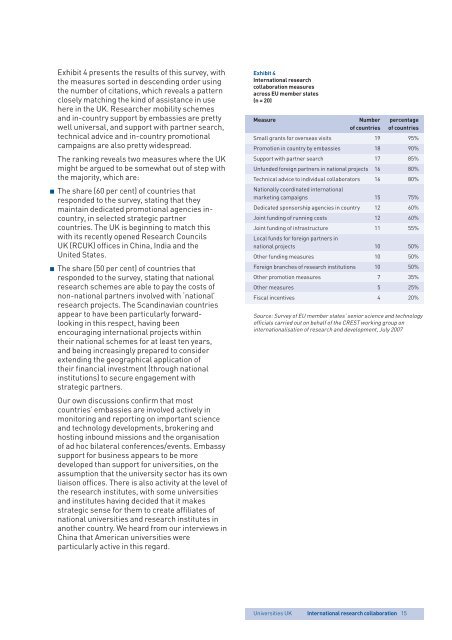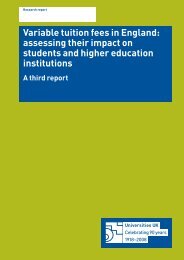International Research Collaboration - GlobalHigherEd
International Research Collaboration - GlobalHigherEd
International Research Collaboration - GlobalHigherEd
Create successful ePaper yourself
Turn your PDF publications into a flip-book with our unique Google optimized e-Paper software.
Exhibit 4 presents the results of this survey, withthe measures sorted in descending order usingthe number of citations, which reveals a patternclosely matching the kind of assistance in usehere in the UK. <strong>Research</strong>er mobility schemesand in-country support by embassies are prettywell universal, and support with partner search,technical advice and in-country promotionalcampaigns are also pretty widespread.The ranking reveals two measures where the UKmight be argued to be somewhat out of step withthe majority, which are:p The share (60 per cent) of countries thatresponded to the survey, stating that theymaintain dedicated promotional agencies incountry,in selected strategic partnercountries. The UK is beginning to match thiswith its recently opened <strong>Research</strong> CouncilsUK (RCUK) offices in China, India and theUnited States.p The share (50 per cent) of countries thatresponded to the survey, stating that nationalresearch schemes are able to pay the costs ofnon-national partners involved with ‘national’research projects. The Scandinavian countriesappear to have been particularly forwardlookingin this respect, having beenencouraging international projects withintheir national schemes for at least ten years,and being increasingly prepared to considerextending the geographical application oftheir financial investment (through nationalinstitutions) to secure engagement withstrategic partners.Our own discussions confirm that mostcountries’ embassies are involved actively inmonitoring and reporting on important scienceand technology developments, brokering andhosting inbound missions and the organisationof ad hoc bilateral conferences/events. Embassysupport for business appears to be moredeveloped than support for universities, on theassumption that the university sector has its ownliaison offices. There is also activity at the level ofthe research institutes, with some universitiesand institutes having decided that it makesstrategic sense for them to create affiliates ofnational universities and research institutes inanother country. We heard from our interviews inChina that American universities wereparticularly active in this regard.Exhibit 4<strong>International</strong> researchcollaboration measuresacross EU member states(n = 20)Measure Number percentageof countries of countriesSmall grants for overseas visits 19 95%Promotion in country by embassies 18 90%Support with partner search 17 85%Unfunded foreign partners in national projects 16 80%Technical advice to individual collaborators 16 80%Nationally coordinated internationalmarketing campaigns 15 75%Dedicated sponsorship agencies in country 12 60%Joint funding of running costs 12 60%Joint funding of infrastructure 11 55%Local funds for foreign partners innational projects 10 50%Other funding measures 10 50%Foreign branches of research institutions 10 50%Other promotion measures 7 35%Other measures 5 25%Fiscal incentives 4 20%Source: Survey of EU member states’ senior science and technologyofficials carried out on behalf of the CREST working group oninternationalisation of research and development, July 2007Universities UK<strong>International</strong> research collaboration 15
















